When people think of grouse in Wyoming, I would imagine greater sage-grouse comes to mind first for many. That’s understandable because Wyoming has the largest number of any state. Plus, the species has been in the news because of reductions in the population and efforts to help them.
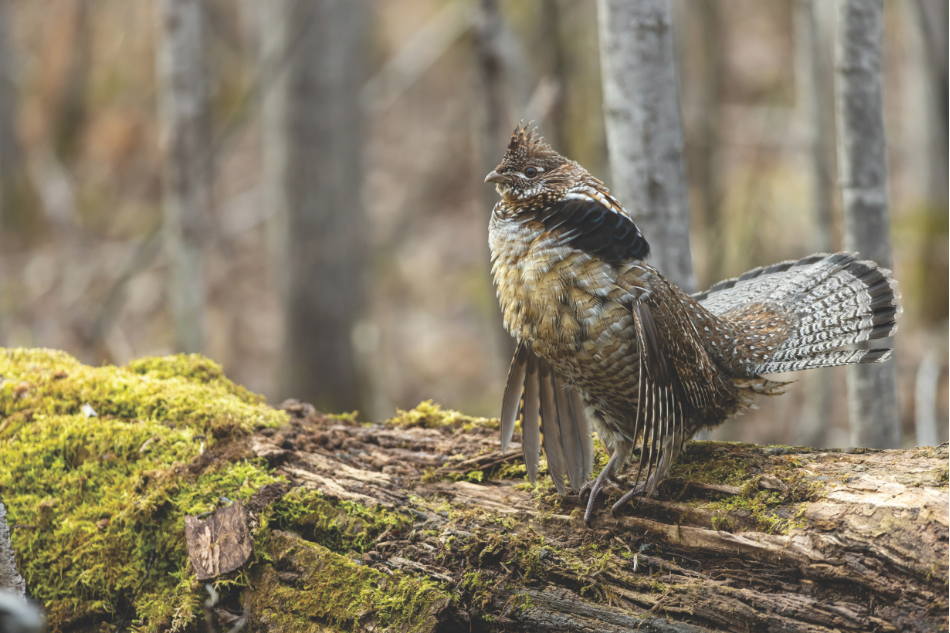
Ruffed grouse are one of four native grouse species in Wyoming. (Adobe Stock Photo)
However, there are three other native grouse species that live here, and all are interesting. In the state's mountain ranges, you can find ruffed grouse and dusky grouse — formerly called blue grouse. The other species is the sharp-tailed grouse of the eastern grasslands and southern foothills.
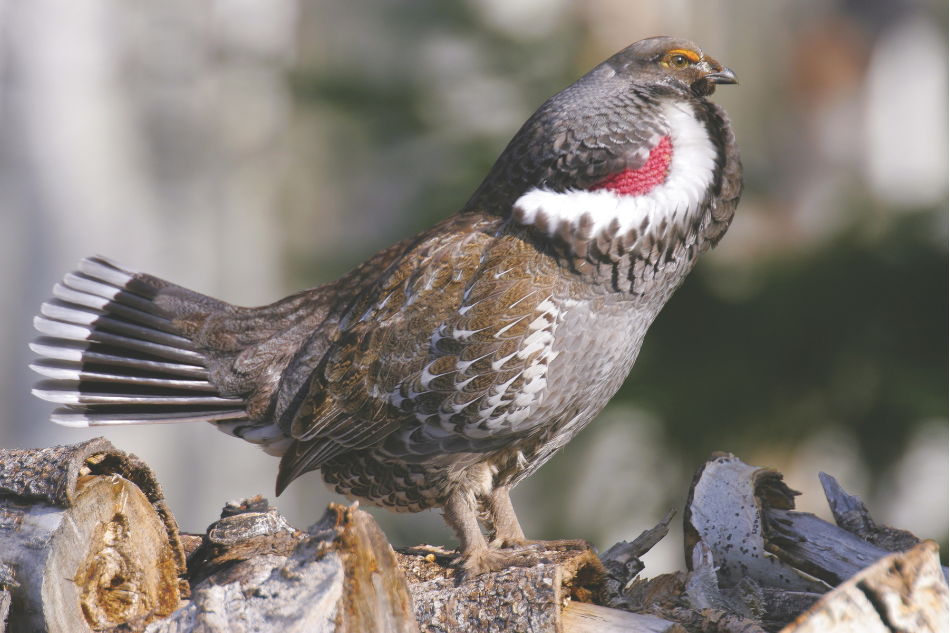
Dusky grouse can be found in some of Wyoming's mountain ranges. These birds aren't surveyed like sharp-tailed grouse because they live in areas where surveys are impractical and individual males display rather than gathering at leks. (Photo by Francis Bergquist)
Sharp-tailed grouse, popularly known as sharpies, are closely related to the greater and lesser prairie chickens of the Great Plains and have been known to hybridize with them where populations overlap. They are medium-sized game birds with primarily grayish-brown feathers and a whitish, short, pointed tail. The wings have an intricate pattern of white spots, and the head feathers can give them a crested appearance when erected.
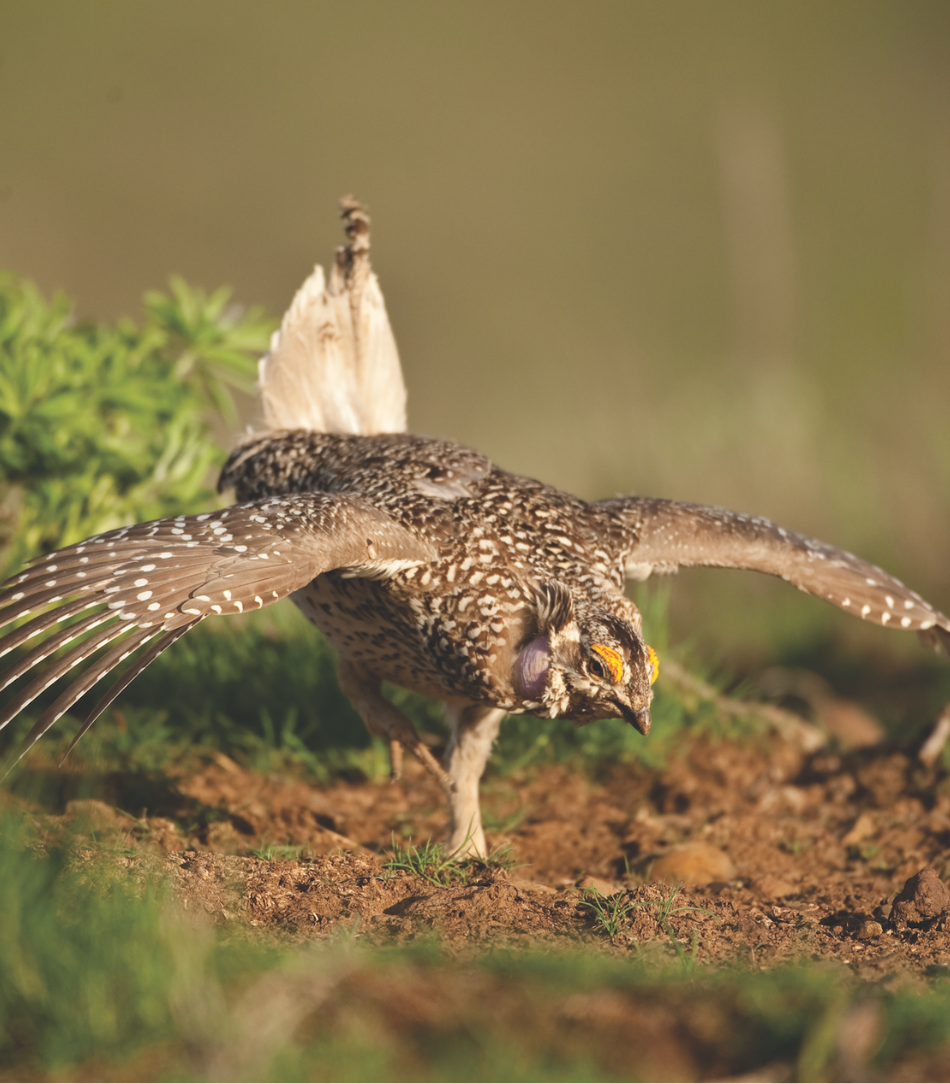
Sharp-tailed grouse are found in Wyoming's eastern grasslands and southern foothills. (Photo by Tim Christie)
During courtship displays, the males, have purple air sacs on the sides of their necks that inflate and bright-yellow eye combs. When displaying, they hold their bodies parallel with the ground while sticking their tails straight up. When seen away from the lek, both sexes have a unique appearance on the ground, looking like a fat-bottomed bowling pin that has fallen about halfway. If you get close to them when they take flight, they can be identified by a characteristic cackle accompanied by the shared grouse characteristic pattern of flight with an explosive takeoff. Then they flap a few times and glide for a short distance before the next flaps. They don’t migrate, although they may move to different habitats within short distances for different seasons of the year.
Surprisingly, Wyoming is toward the southern end of their current range, and they live north all the way to Alaska and the northwest corner of Canada. There are seven recognized subspecies, and Wyoming is blessed to have two of them — Columbian and plains. Columbians have a small population that inhabits the foothills of the Sierra Madre Mountains near Baggs, while the plains subspecies is found east of the Bighorn and Laramie mountains. Sharpies west of the Continental Divide are restricted in range and are not hunted by regulation. The history of the birds in the plains is much more dynamic, starting about 40 years ago.
A LITTLE COVER
Upland game birds have the same requirements to succeed as other wildlife: food, water, habitat and space. Because of the number of eggs they can lay, when conditions are favorable, their numbers can increase rapidly. Sharptails in northeast Wyoming have been able to maintain a good population with less loss of habitat. The problem in southeast Wyoming is there wasn’t habitat that supported them through the year. Large areas have been converted from native rangeland to dryland wheat farming and other uses, and the surviving native range is usually grazed enough with little habitat left. Increasingly, in Laramie County especially, those areas are being lost to rural housing and ranchettes.
Starting in 1985, the United States Department of Agriculture administered the Conservation Reserve Program initiated by the Food Securities Act. This program was designed to decrease erosion on highly erodible lands by paying farmers to plant croplands with perennial vegetation cover, and they would be contracted to keep them in that state for 10 years or longer. A seed mix of grasses and forbs, such as alfalfa, would be provided. Since the wind often blows in Wyoming, a good amount of land in Laramie, Goshen and Platte counties qualified for CRP.
As soon as the parcels of land that were in CRP were established, there was a huge impact on wildlife in the area. It provided reliable cover and some food options that weren’t widely available before, and it was fairly well distributed across the landscape. Sharp-tailed grouse responded immediately with birds and leks appearing in new places in the three counties. Before CRP, no hunting was allowed in the southeast counties because there were so few birds. With the increasing numbers, a hunting season was established in 1989. Not many hunters participated that first year and fewer than 50 birds were taken, but by 2000 the harvest was more than 2,100.
However, nothing remains stagnant in nature, and within a few years the number of birds taken in the hunt dropped dramatically. In 2005, about 1,400 grouse were reported taken — the last season with more than 1,000 birds until 2021.
So, what happened? Extended or acute drought years began to have a sustained impact. Other factors came into play, but the greatest change was in CRP. One grass provided in the seed mix, smooth brome, began to dominate the fields and crowded out the other species of grass and forbs. Some of the benefits declined or went away completely, but one thing that remained was permanent cover, and the grouse still benefited from that. A doctoral study done in the late 1990s demonstrated how important CRP was for the birds. The researcher found all nests were located in CRP, and hens selected patches with a greater diversity of plants.
ON THE DANCE FLOOR
During those same years, a number of survey routes were started in eastern Laramie County, and in Platte County east of Chugwater. They were designed to survey a mix of CRP, cultivated and native range habitats. They always are done the last two weeks of April, because, just like with sage-grouse, counting grouse on their leks is the easiest and the only practical way to monitor their populations, other than with hunting harvest numbers. Lek activity concentrates the birds and makes them more detectable. The sounds emanating from leks make it so leks that can’t be seen due to terrain can still be located, even though those doing the surveys won’t be able to determine the number of birds. Because most of the land in southeast Wyoming is private, the surveys are done from public roads and the surveyors don’t trespass.
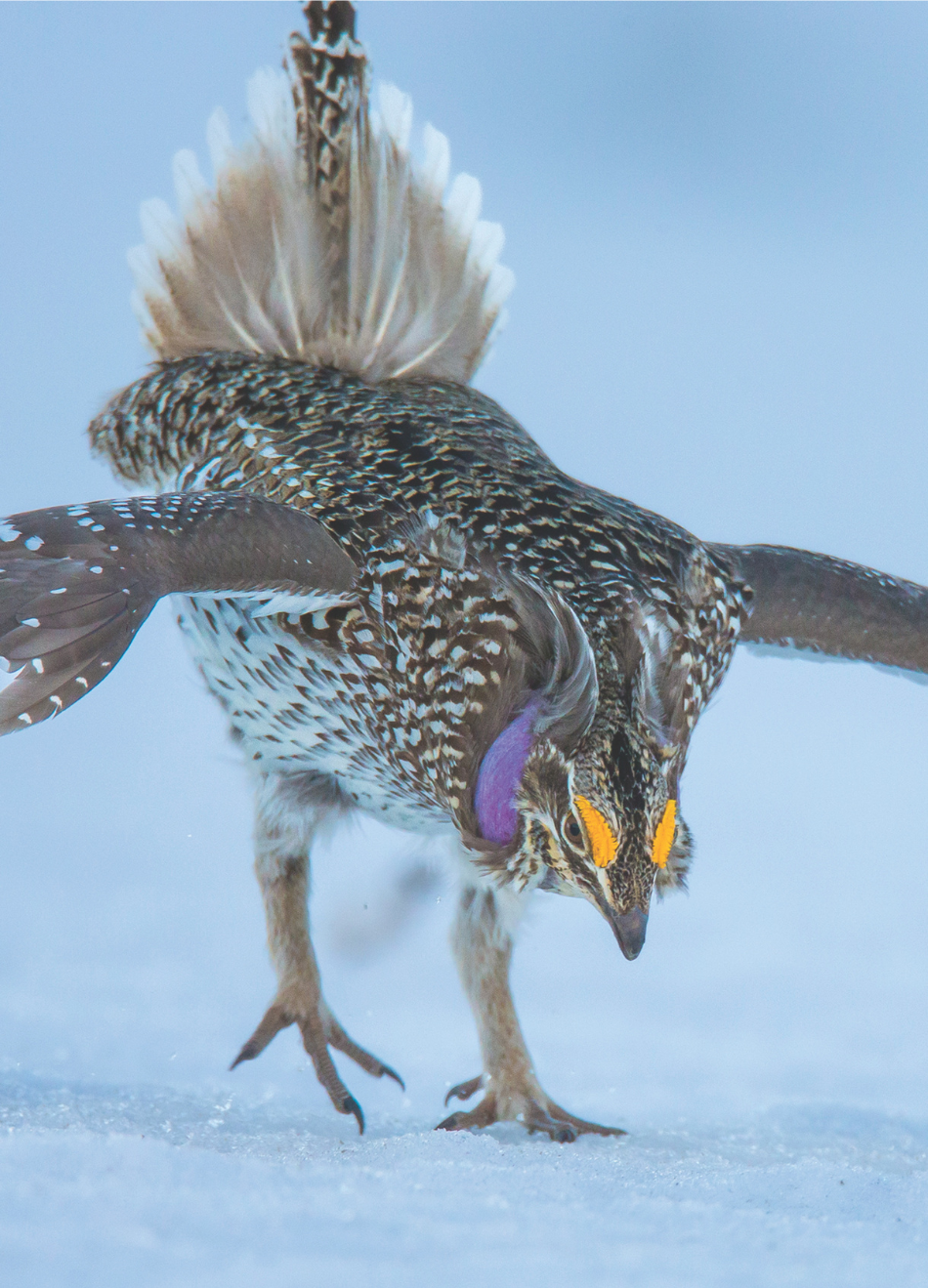
Male sharp-tailed grouse are quite the performers while lekking, including rubbing their tail feathers together.
(Photo by Noppadol Paothong)
These kinds of surveys wouldn’t work for ruffed or dusky grouse that live in areas where survey routes are impractical and they don’t display at leks. For these two species, the males display and call individually, hoping to attract the females in their area.
People think mostly about sage-grouse leks in Wyoming, and for good reason. But if you want real entertainment, try to find a sharp-tailed grouse lek. I compare the two this way: a sage-grouse lek is like watching a waltz; a sharpie lek is like watching a mosh pit. The combination of all the males stomping their feet and rubbing their tail feathers together, dancing in small circles, then all stopping and starting at the same time on some unknown cue, jumping up in the air and fighting make the leks fun to watch. And the noise is truly unique. Six different vocalizations are described: cackle, chilk, coo, cork, gobble and whine. There’s also the tail feather rattle, when the upturned large tail feathers scrape against each other, as well as the sound of the feet stomping on the ground if the observer is close enough. In my book, that’s well worth the price of admission, which consists mostly of getting up really early, driving in the dark and braving what is usually, at best, a face-numbing breeze.
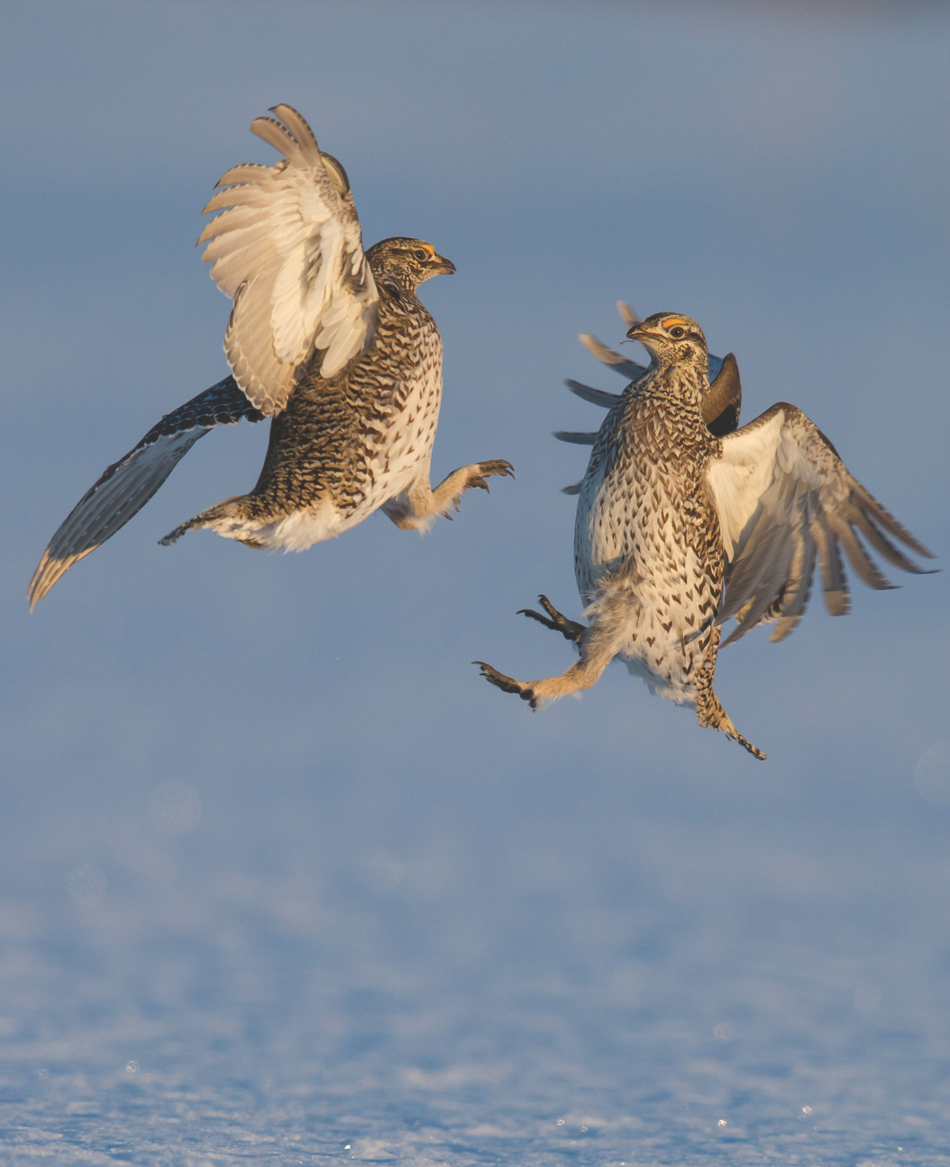
Male sharp-tailed grouse jump in the air and fight when they are lekking. (Photo by Noppadol Paothong)
Working as a Wyoming Game and Fish Department biologist out of Cheyenne means the vast majority of my grouse survey work is for sharpies. I look forward to it each year. It’s a signal that winter is officially over and warmth is not far off. In fact, the difference in how the countryside looks and feels between the first survey date in mid-April and the end of the month can be astounding. It’s greener, warmer and more of the migrant birds have arrived to start their own cycle of mating and raising young. But, to be honest, it’s just fun. I never know what I will encounter. While conducting surveys, I’ve spotted a squadron of long-billed curlews, hundreds of thick-billed longspurs and even briefly watched a pair of northern harriers transport materials for their nest in the middle of a CRP patch. I have done these routes long enough to see changes and watch the fluctuations of the grouse population. It also means I have some interesting interactions with the local people.
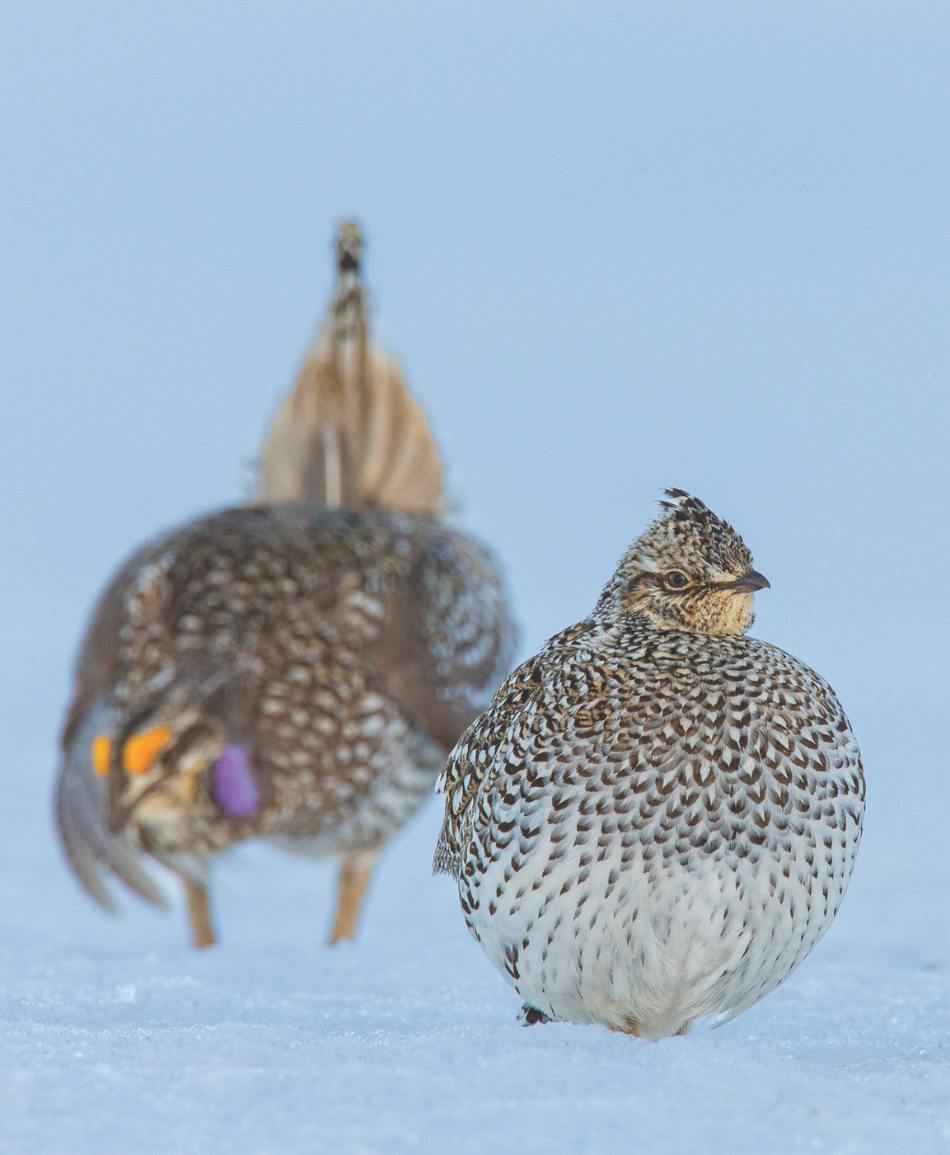
Whether there is snow on the ground or not, a chance to view sharp-tailed grouse in the wild is worth the effort. (Photo by Noppadol Paothong)
For example, at one of my survey route stop points, I pulled over on the side of Wyoming Highway 216 in northeast Laramie County in the early hours of April 19, 2020. To say I was conspicuous standing on the side of the road looking around with binoculars, standing near a green Game and Fish truck and decked out in gloves, a warm hat and a green coat, would be an understatement. I saw few people out and about, and most vehicles that approached slowed to see if I was all right and went on their way with a friendly wave. One truck didn’t just slow; it stopped. The farmer behind the wheel immediately asked, “Do you want to see my chickens”? Normally, that wouldn’t interest me, but I understood by the grin on his face that he wasn’t talking about barnyard fowl. After a short exchange, I followed him down a dirt road. Only half a mile from the highway, he showed me a sharp-tailed grouse lek.
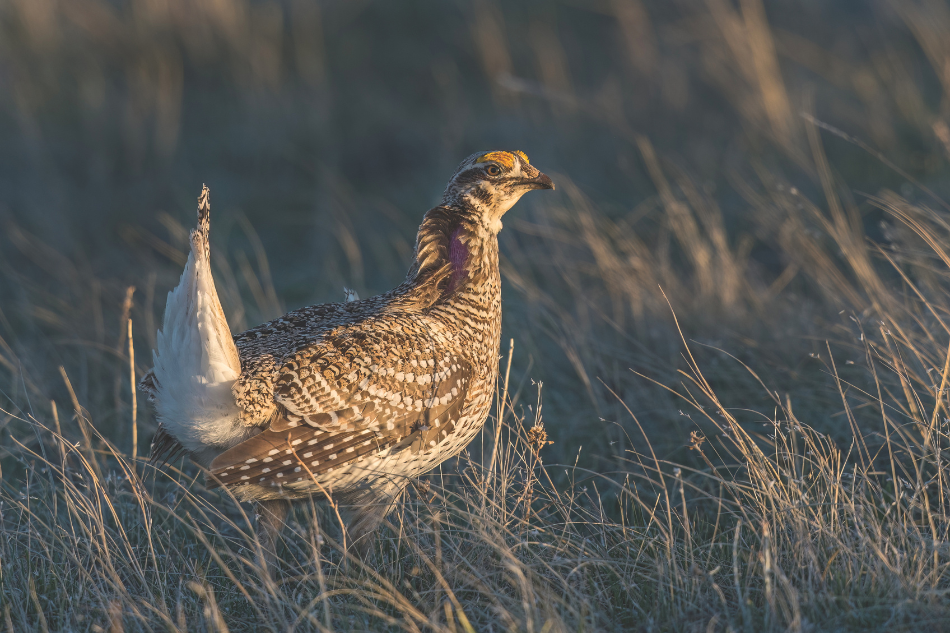
Like with any species of wildlife, habitat is key for sharp-tailed grouse to survive and thrive. (Photo by Dawn Wilson)
Most leks I have seen have 10 or fewer males, and even lower numbers of females, and sharpie leks are not as reliable in their locations as sage-grouse. I have done two routes near Albin for more than a decade. At the beginning of one route, I never know where, or even if, dancing birds will be seen or heard. One year they moved to within 50 yards of the county road, and I was able to get decent video on my cell phone. The next year they were somewhere else, and I barely heard them. This lek was different. It was located in a CRP field with plants that partially screened them from sight, and the birds had been there consistently for a number of years. There were more than 30 males, making it the largest known sharp-tailed lek in the county.
Two years ago, the CRP contract must have expired because it got plowed and planted back into dryland wheat. When that happened, two ideas popped into my head. I was afraid of what would happen to the lek, but I also was curious to see if they would stay through the changes. The answer was yes. Birds continued to lek in the same location, although the numbers were down to about 20 males last year. As long as the population in the immediate vicinity stays fairly stable, that should mean the other males should go somewhere else to lek. So, in future years, I need to be increasingly vigilant about trying to detect where these grouse are shifting their activities to.
The contrast between the sharp-tailed grouse history in northeast and southeast Wyoming provides several stark lessons for land managers and those interested in the birds. The range in northeast Wyoming has remained fairly intact with more of the land being used for grazing of livestock than for crops, and the grouse numbers have remained fairly stable. In southeast Wyoming, the extensive conversion of native grasslands to dryland wheat farming and the subsequent lack of protective cover reduced the grouse to minimal numbers. When CRP provided a patchwork of permanent cover on only about 15 percent of the landscape, the grouse responded immediately and explosively.
To paraphrase that famous line from the movie, “Field of Dreams,” if you build it, the birds will come. Birds continue to demonstrate the point over and over, from ducks in man-made wetlands to bluebirds using nest boxes provided on fence lines, to sharpies in a heavily agricultural landscape.
— Grant Frost is a Wyoming Game and Fish Department senior wildlife biologist based in Cheyenne.

